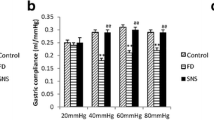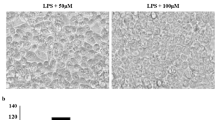Abstract
Background
A traditional Japanese medicine, rikkunshito, has been reported to relieve dyspepsia symptoms. We investigated the effect of rikkunshito on RE-induced abdominal dyspepsia, and performed experiments to elucidate the mechanism of that effect.
Methods
RE model rats were prepared using 8-week-old male Wistar rats, and rikkunshito was administered in drinking water. Voluntary movement was used as an index of RE-induced abdominal dyspepsia, which was monitored by an infrared sensor. On the tenth day after surgery, the total area of esophageal erosion was measured, and samples of nonerosive mucosa were collected. Using those samples, intercellular spaces of epithelial mucosa were examined by transmission electron microscopy, and the NP-40-soluble and -insoluble levels of the tight junction proteins claudin-1, -3 and -4 and their mRNAs were determined.
Results
Rikkunshito did not reduce the average total area of erosive lesions in the esophageal mucosa of RE model rats. On day 10, voluntary movement was significantly decreased in the RE model rats and rikkunshito significantly increased it. Nonerosive esophageal mucosa from RE rats showed dilation of intercellular spaces in epithelium, and significantly decreased claudin-3 mRNA and protein levels. Rikkunshito significantly suppressed intercellular space dilation and significantly increased the level of NP-40-insoluble claudin-3, but it did not affect the mRNA level, suggesting that it promoted tight junction formation by facilitating the translocation of proteins.
Conclusion
Rikkunshito increased voluntary movement in RE model rats. This may have been because rikkunshito ameliorated the symptoms of RE by improving the barrier function of esophageal mucosa.





Similar content being viewed by others
References
Vakil N, van Zanten SV, Kahrilas P, Dent J, Jones R. The Montreal definition and classification of gastroesophageal reflux disease: a global evidence-based consensus. Am J Gastroenterol. 2006;101(8):1900–20.
Dimenäs E. Methodological aspects of evaluation of quality of life in upper gastrointestinal diseases. Scand J Gastroenterol Suppl. 1993;119:18–21.
Dimenäs E, Carlsson G, Glise H, Israelsson B, Wiklund I. Relevance of norm values as part of the documentation of quality of life instruments for use in upper gastrointestinal disease. Scand J Gastroenterol Suppl. 1996;221:8–13.
Venables TL, Newland RD, Patel AC, Hole J, Wilcock C, Turbitt ML. Omeprazole 10 milligrams once daily, omeprazole 20 milligrams once daily, or ranitidine 150 milligrams twice daily, evaluated as initial therapy for the relief of symptoms of gastro-oesophageal reflux disease in general practice. Scand J Gastroenterol. 1997;32:965–73.
Fujiwara Y, Arakawa T. Epidemiology and clinical characteristics of GERD in the Japanese population. J Gastroenterol. 2009;44:518–34.
Dean BB, Gano AD Jr, Knight K, Ofmann JJ, Fass R. Effectiveness of proton pump inhibitors in nonerosive reflux disease. Clin Gastroenterol Hepatol. 2004;2:656–64.
Miwa H, Sasaki M, Furuta T, Koike T, Habu Y, Ito M, et al. Efficacy of rabeprazole on heartburn symptom resolution in patients with non-erosive and erosive gastro-oesophageal reflux disease: a multicenter study from Japan. Aliment Pharmacol Ther. 2007;26:69–77.
Koide A, Yamaguchi T, Koyama H, Koyama H, Tsuyuguchi T, Kitahara H, et al. Effect and role of TJ-43: Rikkun-shi-to from the aspects of endoscopic findings and QOL improvement in GERD patients. Gastroenterology. 2005;128:A-530.
Kawahara H, Kubota A, Hasegawa T, Okuyama H, Ueno T, Ida S, et al. Effects of rikkunshito on the clinical symptoms and esophageal acid exposure in children with symptomatic gastroesophageal reflux. Pediatr Surg Int. 2007;23:1001–5.
Omura N, Kashiwagi H, Chen G, Suzuki Y, Yano F, Aoki T. Establishment of surgically induced chronic acid reflux esophagitis in rats. Scand J Gastroenterol. 1999;34:948–53.
Miwa H, Oshima T, Sakurai J, Tomita T, Matsumoto T, Iizuka S, et al. Experimental oesophagitis in the rat is associated with decreased voluntary movement. Neurogastroenterol Motil. 2009;21:296–303.
Sakakibara A, Furuse M, Saitou M, Ando-Akatsuka Y, Tsukita S. Possible involvement of phosphorylation of occludin in tight junction formation. J Cell Biol. 1997;137:1393–401.
Tatsuta M, Iishi H. Effect of treatment with liu-jun-zi-tang (TJ-43) on gastric emptying and gastrointestinal symptoms in dyspeptic patients. Aliment Pharmacol Ther. 1993;7:459–62.
Tomono H, Ito Y, Watanabe T. Successful antiemetic treatment of TSUMURA Rikkunshi-to extract granules for ethical use in addition to other antiemetic agents in neoadjuvant chemotherapy for an advanced breast cancer patient. Jpn J Cancer Chemother. 2006;33:1129–31.
Oka T, Tamagawa Y, Hayashida S, Kaneda Y, Kodama N, Tsuji S. Rikkunshi-to attenuates adverse gastrointestinal symptoms induced by fluvoxamine. Biopsychosoc Med. 2007;15:21–6.
Hayakawa T, Arakawa T, Kase Y, Akiyama S, Ishige A, Takeda S, et al. Liu-Jun-Zi-Tang, a kampo medicine, promotes adaptive relaxation in isolated guinea pig stomachs. Drugs Exp Clin Res. 1999;25:211–8.
Kido T, Nakai Y, Kase Y, Sakakibara I, Nomura M, Takeda S, et al. Effects of rikkunshi-to, a traditional Japanese medicine, on the delay of gastric emptying induced by N(G)-nitro-l-arginine. J Pharmacol Sci. 2005;98:161–7.
Takeda H, Sadakane C, Hattori T, Katsurada T, Ohkawara T, Nagai K, et al. Rikkunshito, an herbal medicine, suppresses cisplatin-induced anorexia in rats via 5-HT2 receptor antagonism. Gastroenterology. 2008;134:2004–13.
Fujitsuka N, Asakawa A, Hayashi M, Sameshima M, Amitani H, Kojima S, et al. Selective serotonin reuptake inhibitors modify physiological gastrointestinal motor activities via 5-HT2c receptor and acyl ghrelin. Biol Psychiatr. 2009;65:748–59.
Hiyama T, Yoshihara M, Tanaka S, Haruma K, Chayama K. Strategy for treatment of nonerosive reflux disease in Asia. World J Gastroenterol. 2008;28:3123–8.
Tobey NA, Carson JL, Alkiek RA, Orlando RC. Dilated intercellular spaces: a morphological feature of acid reflux-damaged human esophageal epithelium. Gastroenterology. 1996;111:1200–5.
Caviglia R, Ribolsi M, Maggiano N, Gabbrielli AM, Emerenziani S, Guarino MP, et al. Dilated intercellular spaces of esophageal epithelium in nonerosive reflux disease patients with physiological esophageal acid exposure. Am J Gastroenterol. 2005;100:543–8.
Furuse M, Hata M, Furuse K, Yoshida Y, Haratake A, Sugitani Y, et al. Claudin-based tight junctions are crucial for the mammalian epithermal barrier: a lesson from claudin-1-deficient mice. J Cell Biol. 2002;156:1099–111.
Okuyama M, Fujiwara Y, Tanigawa T, Watanabe K, Shiba M, Tominaga K, et al. Roles of ZO-1 and epidermal growth factor in esophageal epithelial defense against acid. Digestion. 2007;75:135–41.
Hashimoto K, Oshima T, Tomita T, Kim Y, Matsumoto T, Joh T, et al. Oxidative stress induces gastric epithelial permeability through claudin-3. Biochem Biophys Res Commun. 2008;376:154–7.
Lu CL, Pasricha PJ, Hsieh JC. Changes of the neuropeptides content and gene expression in spinal cord and dorsal root ganglion after noxious colorectal distention. Regul Pept. 2005;131:66–73.
Donaldson LF, Harmar AJ, McQueen DS, Seckl JR. Increased expression of preprotachykinin, calcitonin gene-related peptide, but not vasoactive intestinal peptide messenger RNA in dorsal root ganglia during the development of adjuvant monoarthritis in the rat. Brain Res Mol Brain Res. 1992;16:143–9.
Banerjee B, Meadda BK, Lazarova Z, Bansal N, Shaker R, Sengupta JN. Effect of reflux-induced inflammation on transient receptor potential vanilloid one (TRPV1) expression in primary sensory neurons innervating the oesophagus of rats. Neurogastroenterol Motil. 2007;19:681–91.
Omura N, Kashiwagi H, Chen G, Yano F, Suzuki Y, Aoki T. Effects of ecabet sodium on experimentally induced reflux esophagitis. J Gastroenterol. 2000;35(7):504–9.
Barlow WJ, Orlando RC. The pathogenesis of heartburn in nonerosive reflux disease: a unifying hypothesis. Gastroenterology. 2005;128:771–8.
Asaoka D, Miwa H, Hirai S, Ohkawa A, Kurosawa A, Kawabe M. Altered localization and expression of tight-junction proteins in a rat model with chronic acid reflux esophagitis. J Gastroenterol. 2005;40:781–90.
Stevenson BR, Goodenough DA. Zonulae occludentes in junctional complex—enriched fractions from mouse liver: preliminary morphological and biochemical characterization. J Cell Biol. 1984;98:1209–21.
Kawahara H, Kubota A, Hasegawa T, et al. Effects of rikkunshito on the clinical symptoms and esophageal acid exposure in children with symptomatic gastroesophageal reflux. Pediatr Surg Int. 2007;23(10):1001–5.
Suzuki H, Inadomi JM, Hibi T. Japanese herbal medicine in functional gastrointestinal disorders. Neurogastroenterol Motil. 2009;21(7):688–96.
Kawahara H, Mitani Y, Nomura M, et al. Impact of rikkunshito, an herbal medicine, on delayed gastric emptying in profoundly handicapped patients. Pediatr Surg Int. 2009;25(11):987–90.
Hayakawa T, Arakawa T, Kase Y, et al. Liu-Jun-Zi-Tang, a kampo medicine, promotes adaptive relation in isolated guinea pig stomachs. Drug Exp Clin Res. 1999;25:211–8.
Acknowledgments
We deeply thank Ms. M. Togawa and N. Kamiya for their technical assistance and Y. Okano for her dedicated secretarial assistance.
Conflict of interest statement
H. Miwa is a consultant to AstraZeneca (Japan) Co. Ltd., Takeda Pharmaceutical Co. Ltd., Eisai Co. Ltd., Tsumura & Co., and Dainippon Sumitomo Pharmaceutical Co. Ltd. T. Matsumoto is a consultant to Tanabe-Mitsubishi Pharmaceutical Co. Ltd., Otsuka Pharmaceuticals Co. Ltd., and Ajinomoto Pharma Co. Ltd. J. Koseki, T. Hattori, K. Kubota and S. Iizuka are employees of Tsumura & Co.
Author information
Authors and Affiliations
Corresponding author
Rights and permissions
About this article
Cite this article
Miwa, H., Koseki, J., Oshima, T. et al. Rikkunshito, a traditional Japanese medicine, may relieve abdominal symptoms in rats with experimental esophagitis by improving the barrier function of epithelial cells in esophageal mucosa. J Gastroenterol 45, 478–487 (2010). https://doi.org/10.1007/s00535-009-0180-1
Received:
Accepted:
Published:
Issue Date:
DOI: https://doi.org/10.1007/s00535-009-0180-1




